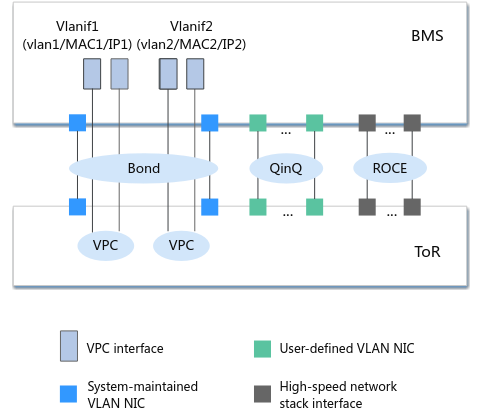Networks
BMS network types include:
- VPC
- High-speed network
- User-defined VLAN
|
Network |
Network Feature |
x86 V4 BMS |
x86 V5 BMS |
x86 V6 BMS |
Kunpeng BMS |
|---|---|---|---|---|---|
|
VPC |
Supported |
Yes |
Yes |
Yes |
Yes |
|
Bandwidth |
10 GE |
10 GE |
40 GE |
40 GE |
|
|
Number of NICs |
2 |
2 |
32 |
32 |
|
|
High-speed network |
Supported |
Yes |
Yes |
No |
No |
|
Bandwidth |
Share the bandwidth with VPCs. |
Share the bandwidth with VPCs. |
N/A |
N/A |
|
|
User-defined Network |
Supported |
Yes. User-defined networks depend on dedicated gateways. |
Yes. User-defined networks depend on dedicated gateways. |
No |
No |
BMS provides four types of networks: VPC, high-speed network, user-defined VLAN, and high-speed network stack. They are isolated from each other.
x86 V4/V5 BMS:
VPC and high-speed network interfaces are VLAN sub-interfaces created after system maintenance VLAN NICs are bonded. You can manage and configure NICs of user-defined VLANs.
x86 V6/Kunpeng BMS:
The QingTian architecture improves the network performance and VPC NIC bonding provides high reliability.


- In the preceding figure, ToR indicates the cabling mode in the server cabinet. The access switch is placed on top of the rack and the server is placed beneath it. QinQ indicates 802.1Q tunneling.
- The VPC interface generated by the system cannot be modified.
- BMSs can communicate with ECSs through VPCs.
- Only VPC supports security groups, EIPs, and ELB.
- For a high-speed network and user-defined VLAN, BMSs in the same network communicate with each other only through layer-2 connections.
VPC
A VPC is a logically isolated, configurable, and manageable virtual network. It helps improve the security of cloud resources and simplifies network deployment. You can create security groups and VPNs, configure IP address ranges, and specify bandwidth sizes in your VPC. With a VPC, you can easily manage and configure internal networks and change network configurations. You can also customize access rules to control BMS access within a security group and across different security groups to enhance BMS security.
For more information, see Virtual Private Cloud Service Overview.
High-Speed Network
A high-speed network is an internal network between BMSs. It provides high bandwidth for connecting BMSs in the same AZ. If you want to deploy services that require high throughput and low latency, you can create high-speed networks. Currently, the BMS service supports high-speed networks with a maximum bandwidth of 10 Gbit/s.
Enhanced high-speed networks use upgraded hardware and software and provide performance superior to high-speed networks.
Enhanced high-speed networks have the following advantages:
- The bandwidth is 10 Gbit/s or higher.
- The number of network planes can be customized and a maximum of 4,000 subnets are supported.
User-defined VLAN
You can use the 10GE Ethernet NICs that are not being used by the system to configure a user-defined VLAN. The QinQ technology is used to isolate networks and provide additional physical planes and bandwidths. You can create VLANs to isolate network traffic. User-defined VLAN NICs are in pairs. You can configure NIC bonding to achieve high availability. User-defined VLANs in different AZs cannot communicate with each other.

QinQ is a layer 2 tunnel protocol based on IEEE 802.1Q encapsulation. It adds a public VLAN tag to a frame with a private VLAN tag and allows the frame with double VLAN tags to be transmitted over the service provider's backbone network based on the public VLAN tag. This provides a layer 2 VPN tunnel for customers.
Feedback
Was this page helpful?
Provide feedbackThank you very much for your feedback. We will continue working to improve the documentation.See the reply and handling status in My Cloud VOC.
For any further questions, feel free to contact us through the chatbot.
Chatbot





